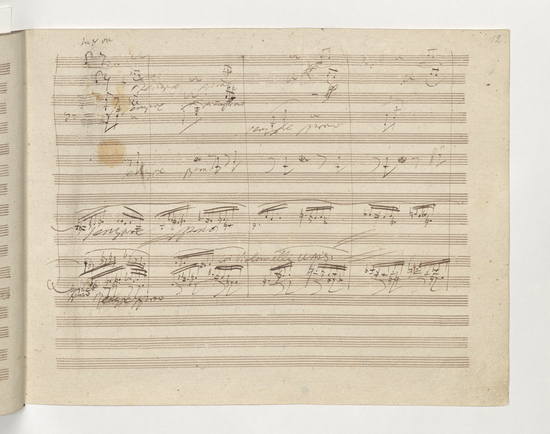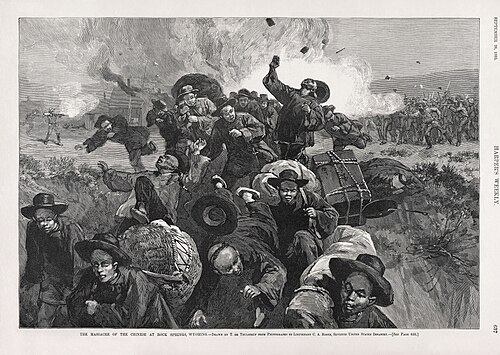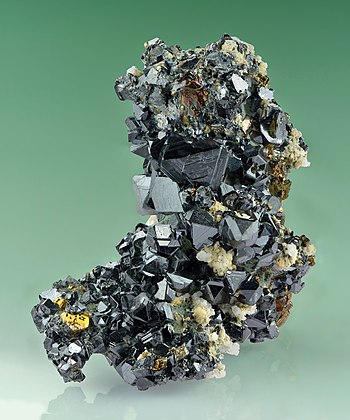Wikipedia:Picture of the day/Archive
|
Featured picture tools: |
These featured pictures, as scheduled below, appeared as the picture of the day (POTD) on the English Wikipedia's Main Page in the last 30 days.
You can add an automatically updating POTD template to your user page using {{Pic of the day}} (version with blurb) or {{POTD}} (version without blurb). For instructions on how to make custom POTD layouts, see Wikipedia:Picture of the day.Purge server cache
May 16

|
|
The Valère Basilica is a fortified Catholic church in Sion, in the Swiss canton of Valais. It is situated on a hill at an altitude of 615 metres (2,018 ft), and faces Tourbillon Castle located on the opposite hill. The first parts of the building were constructed around 1100, with numerous additions over the subsequent centuries. It was designated a minor basilica in 1987. The site is a listed as a Swiss heritage site of national significance, which includes the surrounding hill due to the large number of protected plant and animal species present there. This photograph shows the Valère Basilica in February 2021, with the Haut de Cry, a 2,969-metre (9,741 ft) peak of the Bernese Alps, in the background. Photograph credit: Christian David
Recently featured:
|
May 15
_at_Guango_Lodge%2C_Ecuador_(21310837273).jpg/350px-Sword-billed_hummingbird_(male)_at_Guango_Lodge%2C_Ecuador_(21310837273).jpg)
|
The sword-billed hummingbird (Ensifera ensifera) is a neotropical species of hummingbird from the Andean regions of South America. Among the largest species of hummingbird, it is characterized by its unusually long beak, being the only bird to have a beak longer than the rest of its body, excluding the tail. It uses this to drink nectar from flowers with long corollas and has coevolved with the plant Passiflora mixta. While most hummingbirds preen using their beaks, the sword-billed hummingbird uses its feet to scratch and preen due to its beak being so long. Photograph credit: Andy Morffew
Recently featured:
|
May 14

|
The Tarantula Nebula, also known as 30 Doradus, is a large H II region in the Large Magellanic Cloud (LMC). It is one of the largest H II regions in the Local Group, with an estimated diameter around 650 to 1860 light years. It is around 160,000 light-years from Earth and has apparent magnitude of 8. The Tarantula Nebula was first observed by Nicolas-Louis de Lacaille during an expedition to the Cape of Good Hope between 1751 and 1753. This high-resolution photograph was taken by the Hubble Space Telescope and shows the star-forming region of Tarantula Nebula with the R136 super star cluster at its center. Photograph credit: NASA, ESA, Space Telescope Science Institute
Recently featured:
|
May 13

|
|
The Monteleone chariot is an Etruscan chariot, dated to circa 530 BC, that was uncovered in 1902 at Monteleone di Spoleto in Umbria, Italy, in an underground tomb covered by a mound. It was part of a chariot burial, containing the remains of two human corpses along with two drinking cups. Measuring 131 centimetres (51+5⁄8 inches) in height and designed to be drawn by two horses, the chariot itself is constructed of wood covered with hammered bronze plates and carved ivory decoration. The Monteleone chariot is now in the collection of the Metropolitan Museum of Art in New York City. Artifact credit: unknown Etruscan sculptor; photographed by the Rogers Fund and the Metropolitan Museum of Art
Recently featured:
|
May 12
|
Carpocoris purpureipennis is a species in the shield bug family, Pentatomidae. With a length of 11–13 millimetres (0.43–0.51 in), its body color varies from purple or reddish-brown to yellowish. The pronotum angles are black and the pronotum usually shows short longitudinal black stripes, while the scutellum may have some contrasting black spots. The insect's antennae are black and its legs are orange. Both the adult bugs and their nymphs are polyphagous. Adults mainly feed on juices of Cirsium arvense and nectar of Leucanthemum vulgare. These images show top and bottom views of a C. purpureipennis nymph. Photograph credit: Ivar Leidus
Recently featured:
|
May 11

|
|
Sagunto is a municipality of Spain, located in the province of Valencia, approximately 30 km (19 mi) north of the city of Valencia. The municipality includes three differentiated urban nuclei: Ciutat Vella (Sagunto), Grau Vella and Puerto de Sagunto. More than half of the population lives in Puerto de Sagunto, situated on the Mediterranean Costa del Azahar. The Ciutat Vella is the site of the ancient Iberian and Roman city of Saguntum and a siege in 219 BC which was the trigger of the Second Punic War between the Carthaginians and the Romans. This panorama shows the Ciutat Vella, looking north from the hill on which Sagunto Castle stands. Photograph credit: Diego Delso
Recently featured:
|
May 10

|
The Rokeby Venus is a painting by Diego Velázquez which was completed between 1647 and 1651. It depicts the Roman goddess Venus in a sensual pose, lying on a bed and looking into a mirror held by her son Cupid. The painting is the only surviving female nude by Velázquez. Since 1906 it has been in the National Gallery in London. Painting: Diego Velázquez
Recently featured:
|
May 9

|
The acorn woodpecker (Melanerpes formicivorus) is a bird in the woodpecker family, Picidae. It is found across Central America, as well as the western United States and parts of Colombia. A medium-sized bird, it has a length of around 20 cm (8 in) and is mostly black, and adult males have a red cap starting at the forehead and females a black area between the forehead and the cap. As their name implies, acorn woodpeckers are heavily dependent on acorns for food, which they store in small holes that they drill into trees, known as "granaries" or "storage trees". This acorn woodpecker was photographed in the grounds of California State University, Chico, United States. Photograph credit: Frank Schulenburg
Recently featured:
|
May 8
.jpg/300px-Portrait_of_Yi_Haeung_(National_Museum_of_Korea).jpg)
|
Heungseon Daewongun (1821–1898) was the title of Yi Ha-eung, the regent of Joseon during the minority of Emperor Gojong in the 1860s. Until his death, he was a key political figure of late-Joseon Korea. The Daewongun is remembered both for the wide-ranging reforms that he attempted during his regency, as well as for what was described by historian Hilary Conroy as "vigorous enforcement of the seclusion policy, persecution of Christians, and the killing or driving off of foreigners who landed on Korean soil". This silk painting of the Daewongun, now in the collection of the National Museum of Korea, was created by an unknown artist circa 1869. It is designated as a Treasure of Korea. Painting credit: unknown
Recently featured:
|
May 7

|
|
The Symphony No. 9 in D minor, Op. 125, is a choral symphony, the final complete symphony by Ludwig van Beethoven, composed between 1822 and 1824. It was first performed in Vienna on 7 May 1824. The symphony is regarded by many critics and musicologists as a masterpiece of Western classical music. It is one of the best-known works in common practice music and one of the most frequently performed symphonies worldwide. Symphony No. 9 was the first example of a major composer scoring vocal parts in a symphony. In the 20th century, an instrumental arrangement of the chorus was adopted by the Council of Europe, and later the European Union, as the Anthem of Europe. This photograph displays page 12 of Beethoven's original manuscript and is currently held in the collection of the Berlin State Library. Manuscript credit: Ludwig van Beethoven
Recently featured:
|
May 6
.jpg/550px-Troodos_lizard_(Phoenicolacerta_troodica).jpg)
|
|
Phoenicolacerta troodica, commonly known as the Troodos lizard or the Troodos wall lizard, is a species of lizard in the family Lacertidae. It is endemic to Cyprus, where it is common and widespread and its natural habitats are Mediterranean-type shrubland and rocky areas, in both rural and urban areas. Its length is up to 22 centimetres (8.7 inches), with males slightly larger than females. The species has a long tail, which can grow to more than twice its body length. This P. troodica lizard was photographed under the Elia Bridge in Limassol District, Cyprus. Photograph credit: Charles J. Sharp
Recently featured:
|
May 5
.jpg/400px-Amédée_Forestier_-_Illustrated_London_News_-_Gilbert_and_Sullivan_-_Ruddygore_(Ruddigore).jpg)
|
Ruddigore is a comic opera in two acts, with music by Arthur Sullivan and a libretto by W. S. Gilbert. The tenth of fourteen comic operas written together by Gilbert and Sullivan, it was first performed by the D'Oyly Carte Opera Company at the Savoy Theatre in London in 1887. Some critics and audience members initially felt that Ruddygore (its original title) did not measure up to its predecessor, The Mikado. After changes, including respelling the title, it achieved a run of 288 performances and was profitable. This 1887 illustration by Amédée Forestier depicts scenes and characters from Ruddygore for The Illustrated London News. Since D'Oyly Carte revived the piece in 1920, it has been regularly performed. Illustration credit: Amédée Forestier; restored by Adam Cuerden
Recently featured:
|
May 4

|
|
The Nazca lines are a group of geoglyphs made in the soil of the Nazca Desert in southern Peru. They were created in two major phases – the Paracas phase (from 400 to 200 BC) and the Nazca phase (from 200 BC to 500 AD). The combined length of all the lines is more than 1,300 km (800 mi), and the group covers an area of about 50 km2 (19 sq mi). Most lines run straight across the landscape, but there are also figurative designs of animals and plants. Scholars differ in interpreting the purpose of the designs, but in general, they ascribe religious significance to them. The lines were designated as a UNESCO World Heritage Site in 1994. This is an aerial view of the geoglyph known as the "monkey", one of the most well-known in the Nazca lines. Photograph credit: Diego Delso
Recently featured:
|
May 3

|
The great blue turaco (Corythaeola cristata) is a bird species in the turaco family, Musophagidae, which is widespread throughout the African tropical rainforest. It has a typical length of around 75 cm (30 in) with a mass of around 1 kg (2 lb). The adult great blue turaco has predominantly gray-blue upperparts with an upright blue-black crest. Its bill is yellow and the two sexes have similar plumage. This great blue turaco was photographed in Kibale National Park, Uganda. Photograph credit: Giles Laurent
Recently featured:
|
May 2

|
|
John Rocque's maps of London were published in 1746. A French-born British surveyor and cartographer, John Rocque produced two maps of London and the surrounding area. The better known of these, depicted here, is a 24-sheet map of the City of London and the surrounding area, surveyed by Rocque and engraved by John Pine and titled A Plan of the Cities of London and Westminster, and Borough of Southwark. Rocque combined two surveying techniques: he made a ground-level survey with a compass and a physical metal chain – the unit of length also being the chain. Compass bearings were taken of the lines measured. He also created a triangulation network over the entire area to be covered by taking readings from church towers and similar high places using a theodolite made by Jonathan Sisson (the inventor of the telescopic-sighted theodolite) to measure the observed angle between two other prominent locations. The process was repeated from point to point. This image depicts all 24 sheets of Rocque's map. Map credit: John Rocque and John Pine
Recently featured:
|
May 1

|
|
The Rock Springs massacre occurred in 1885 in the present-day United States city of Rock Springs, Wyoming. The riot, and resulting massacre of immigrant Chinese miners by white immigrant miners, was the result of racial prejudice toward the Chinese miners, who were perceived to be taking jobs from the white miners. The Union Pacific Coal Department found it economically beneficial to give preference in hiring to Chinese miners, who were willing to work for lower wages than their white counterparts, angering the white miners. When the rioting ended, at least 28 Chinese miners were dead and 15 were injured. Rioters burned 78 Chinese homes, resulting in approximately $150,000 in property damage (equal to $5.09 million in 2020 terms). The massacre in Rock Springs touched off a wave of anti-Chinese violence, especially in the Puget Sound area of Washington Territory. Artwork credit: Thure de Thulstrup; restored by Adam Cuerden
Recently featured:
|
April 30

|
Pelléas et Mélisande is an opera in five acts with music by the French composer Claude Debussy. The French-language libretto was adapted from Maurice Maeterlinck's symbolist play Pelléas and Mélisande. The plot concerns a love triangle between Prince Golaud, Mélisande (a mysterious young woman he had found lost in a forest), and Golaud's younger half-brother Pelléas. The only opera Debussy ever completed, Pelléas et Mélisande premiered on 30 April 1902 at the Salle Favart in Paris, performed by the Opéra-Comique, with Jean Périer as Pelléas and Mary Garden as Mélisande. The premiere was conducted by André Messager, who was instrumental in getting the Opéra-Comique to stage the work. This poster by the French painter Georges Rochegrosse was produced for the premiere. Poster credit: Georges Rochegrosse; restored by Adam Cuerden
Recently featured:
|
April 29

|
Sphalerite is a sulfide mineral with the chemical formula (Zn,Fe)S. It is found in a variety of deposit types, and is found in association with galena, chalcopyrite, pyrite (and other sulfides), calcite, dolomite, quartz, rhodochrosite, and fluorite. Sphalerite is an important ore of zinc, with around 95 percent of all primary zinc extracted from its ore. Due to its variable trace-element content, sphalerite is also an important source of several other metals such as cadmium, gallium, germanium and indium. The zinc in sphalerite is also used to produce brass. This sample was extracted in Creede, Colorado, and features black tetrahedral crystals of sphalerite up to 8 mm (0.31 in) in size, with minor chalcopyrite and calcite, in a 4.5 cm × 3.0 cm × 2.0 cm (1.77 in × 1.18 in × 0.79 in) matrix. This photograph was focus-stacked from 125 separate images. Photograph credit: Ivar Leidus
Recently featured:
|
April 28
_male_dorsal_side.jpg/550px-Broad-bodied_chaser_(Libellula_depressa)_male_dorsal_side.jpg)
|
|
Libellula depressa, commonly known as the broad-bodied chaser or broad-bodied darter, is a dragonfly in the family Libellulidae. One of the most common dragonflies in Europe and central Asia, its range extends to England, central Asia and the Middle East, with a few limited populations in Scotland. It is not found in Ireland or North Africa, however. This insect is around 39 to 48 millimetres (1.5 to 1.9 inches) in length, with both the male and the female having a broad, flattened abdomen which is brown with yellow patches down the sides. In the male, the abdomen develops a blue pruinescence that covers the brown colour. Both fore and hind wings have a dark patch at the base. This male L. depressa dragonfly was photographed at Wolvercote Lakes in Oxfordshire, England. Photograph credit: Charles J. Sharp
Recently featured:
|
April 27

|
Benjamin Franklin Tilley (1848–1907) was a career officer in the United States Navy who served from the end of the American Civil War through the Spanish–American War. He is best remembered as the first acting governor of American Samoa as well as the territory's first naval governor. Photograph credit: unknown photographer; Naval History and Heritage Command; restored by Adam Cuerden
Recently featured:
|
April 26

|
|
Lichfield Cathedral is a Church of England cathedral in Lichfield, in the English county of Staffordshire. A cathedral was first built on the site in 700, by Bishop Headda, to house the bones of St Chad. The original wooden building was replaced by a Norman cathedral made from stone, which in turn was replaced by the present Gothic structure, begun in 1195. The fabric of the cathedral suffered in the English Civil War, when it was used as a defensive structure. In the 18th century the interior was extensively remodelled, with major structural work organised by James Wyatt; this involved removing the high altar to make a single worship area consisting of the choir and lady chapel, and adding a massive stone screen at the entrance to the choir. This photograph shows the choir of the cathedral, which was built around 1200. Photograph credit: David Iliff
Recently featured:
|
April 25
_male.jpg/350px-Madagascar_stonechat_(Saxicola_sibilla)_male.jpg)
|
The Madagascar stonechat (Saxicola sibilla) is a species of stonechat endemic to Madagascar. It is a small bird, closely similar to the African stonechat in both plumage and behaviour, but distinguished from it by the more extensive black on the throat and minimal orange-red on the upper breast of the males. This male Madagascar stonechat perching on a branch was photographed in Analamazaotra National Park, near Andasibe. Photograph credit: Charles J. Sharp
Recently featured:
|
April 24

|
Luis Walter Alvarez (1911–1988) was an American experimental physicist who was awarded the Nobel Prize in Physics in 1968 for his discovery of resonance states in particle physics using the hydrogen bubble chamber. After receiving his PhD from the University of Chicago in 1936, Alvarez went to work for Ernest Lawrence at the Radiation Laboratory at the University of California, Berkeley. He joined MIT Radiation Laboratory in 1940, where he contributed to a number of World War II radar projects and worked as a test pilot, before joining Robert Oppenheimer on the Manhattan Project in 1943. He moved back to Berkeley as a full professor after the war, going on to use his knowledge in work on improving particle accelerators. This 1969 photograph shows Alvarez with a magnetic monopole detector at Berkeley. Photograph credit: Lawrence Berkeley National Laboratory / Department of Energy
Recently featured:
|
April 23

|
Bistorta officinalis, also known as he common bistort, is a species of flowering plant in the dock family Polygonaceae. It is native to Europe and northern and western Asia, but has also been cultivated and become naturalized in other parts of the world such as in the United States. It is typically found growing in moist meadows, nutrient-rich wooded swamps, forest edges, wetlands, parks, gardens and disturbed ground. A herbaceous perennial, it grows to a height of 20 to 80 centimetres (8 to 31 inches). It blooms from late spring into autumn, producing tall, erect, unbranched and hairless stems ending in single terminal racemes that are club-like spikes, 5 to 7 centimetres (2 to 3 inches) long, of rose-pink flowers. This B. officinalis inflorescence was photographed in the Austrian Alps. Photograph credit: Uoaei1
Recently featured:
|
April 22
.jpg/400px-Cyprus_water_frog_(Pelophylax_cypriensis).jpg)
|
Pelophylax cypriensis, commonly known as the Cyprus water frog, is a species of frog in the family Ranidae, the true frogs. It is endemic to Cyprus. It is a medium-sized frog, with females (body length up to 75 mm, 3.0 in) being larger than males (up to 65 mm, 2.6 in). The skin is rather warty and colouration varies widely. There are four unwebbed toes on the front legs and five webbed toes on the hindlegs. Males have paired external vocal sacs. This Cyprus water frog was photographed under the Elia Bridge in Limassol District, Cyprus. Photograph credit: Charles J. Sharp
Recently featured:
|
April 21

|
Walter White (1893–1955) was an American civil rights activist who led the National Association for the Advancement of Colored People (NAACP) for a quarter of a century, from 1929 until his death. He directed a broad program of legal challenges to racial segregation and disfranchisement. Under his leadership, the NAACP oversaw the plans and organizational structure of the fight against public segregation in the United States. He worked with President Harry S. Truman on desegregating the armed forces after World War II and gave him a draft of Executive Order 9981 to implement this. Under White's leadership, the NAACP set up its Legal Defense Fund, which conducted numerous legal challenges to segregation and disfranchisement, and achieved many successes. This photograph of White was taken by Clara Sipprell around 1950, and is in the collection of the National Portrait Gallery in Washington, D.C. Photograph credit: Clara Sipprell; restored by Adam Cuerden
Recently featured:
|
April 20

|
|
Tarazona is a town and municipality, and the capital of the comarca Tarazona y el Moncayo in Aragon, Spain. It is also the seat of the Roman Catholic Diocese of Tarazona. Located on the river Queiles, a tributary of the Ebro, Tarazona was an important regional centre of ancient Rome, known as Turiaso, located around 60 kilometres (37 miles) from Bilbilis. The city later came under the rule of the Visigoths, who called it Tirasona. This view of Tarazona was taken from the city's episcopal palace, and shows Tarazona Cathedral and its seminary, the Old Bullfight Arena, and the Sanctuary of the Lady of the River. Photograph credit: Diego Delso
Recently featured:
|
April 19

|
Picea omorika, commonly known as the Pančić spruce or the Serbian spruce, is a species of coniferous tree endemic to the valley of the Drina in western Serbia, and eastern Bosnia and Herzegovina, with a total range of only about 60 hectares (150 acres) at altitudes of 800 to 1,600 metres (2,625 to 5,249 ft). The species was originally discovered near the Serbian village of Zaovine on Mount Tara in 1875, and named by the Serbian botanist Josif Pančić. It is a medium-sized evergreen tree that generally grows to a height of around 20 metres (66 ft), with a trunk diameter of up to 1 metre (3 ft). It has buff-brown shoots with dense hair coverage and needle-like leaves. Its cones are fusiform in shape and grow to a length of 4 to 7 centimetres (2 to 3 in). They are dark purple when young, maturing to dark brown, and have stiff scales. This young female P. omorika cone, with a length of 22 millimetres (0.87 in), was photographed near Keila, Estonia. Photograph credit: Ivar Leidus
Recently featured:
|
April 18
|
A basso porto (At the Lower Harbour) is an opera in three acts by the Italian composer Niccola Spinelli. The opera sets an Italian-language libretto by Eugene Checchi, based on Goffredo Cognetti's 1889 play O voto. It premiered to critical success at the Cologne Opera on April 18, 1894, sung in a German translation by Ludwig Hartmann and Otto Hess. This watercolour illustration depicts the set design by Riccardo Salvadori for act 1 of the opera's premiere. A basso porto is set in the slums of Naples, and Spinelli included mandolins and guitars in his orchestral score. Set design credit: Riccardo Salvadori
Recently featured:
|
April 17

|
The American white pelican (Pelecanus erythrorhynchos) is a large aquatic soaring bird from the order Pelecaniformes. It breeds in interior North America, moving south and to the coasts, as far as Costa Rica, in winter. Along with the trumpeter swan, it is one of the longest birds native to North America, with an overall length of about 50 to 70 inches (130 to 180 cm). The beak measures 11.3 to 15.2 inches (290 to 390 mm) in males and 10.3 to 14.2 inches (260 to 360 mm) in females, while its wingspan is around 95 to 120 inches (240 to 300 cm). The American white pelican does not dive for its food as some other pelican species do, instead catching its prey while swimming. Each bird eats more than 4 pounds (1.8 kg) of food a day, predominantly fish, which ranges from the size of minnows to 3.5-pound (1.6 kg) pickerels. This adult American white pelican in non-breeding plumage was photographed at Las Gallinas Wildlife Ponds in San Rafael, California. Photograph credit: Frank Schulenburg
Recently featured:
|
Picture of the day archives and future dates

_-_Kulna.jpg/240px-Carpocoris_purpureipennis_fifth_instar_nymph_(top_view)_-_Kulna.jpg)
_-_Kulna.jpg/240px-Carpocoris_purpureipennis_fifth_instar_nymph_(bottom_view)_-_Kulna.jpg)